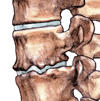.jpg) Contemporary treatment for neck spondylosis
Contemporary treatment for neck spondylosis
Is the mild neck discomfort you experienced a few months or years ago getting worse? Maybe you’ve noticed the mild neck discomfort is now neck pain, and is accompanied b1y odd sensations such as tingling and numbness. Perhaps symptoms travel into one or both arms. Moreover, your usual range of neck movement is now limited by pain and stiffness. You ask yourself, “What is wrong with my neck?”
Cervical Spondylosis
 It could be a common neck problem called cervical spondylosis; sometimes called spinal osteoarthritis. Cervical spondylosis is a degenerative process and usually begins between the ages of 45 to 55. What happens? The structural integrity of the spine’s discs, joints and cartilage is affected in response to normal age-related cellular changes.
It could be a common neck problem called cervical spondylosis; sometimes called spinal osteoarthritis. Cervical spondylosis is a degenerative process and usually begins between the ages of 45 to 55. What happens? The structural integrity of the spine’s discs, joints and cartilage is affected in response to normal age-related cellular changes.
The illustration (above) depicts a thinning disc and loss of disc height. The disc is not able to normally absorb and distribute body stresses. Furthermore, lost disc height narrows nerve passageways and leads to nerve compression (pinched nerves). The wavy pattern represents bone spurs (osteophytes) that can pinch nerves too. Spinal instability can develop as a result of bone spur formation.
You Have Options
The first step is to consult a spine physician that specializes in cervical spine conditions—a neurosurgeon. Keep in mind that making an appointment to consult a neurosurgeon is different from making an appointment for surgery! In fact, only a small percentage of all neck pain patients needs surgery. The majority of patients are treated non-surgically with medication, physical therapy, or injection therapies.
Your neurosurgeon may recommend spine surgery if non-operative therapies fail, pain is unrelenting, nerve problems occur, or spinal instability develops. If surgery is discussed you have options, which may include being a candidate for cervical artificial disc placement.
Contemporary Treatment Option
Cervical Artificial Disc
A cervical artificial disc is constructed from stainless steel, titanium and polyurethane to act like a natural human disc. An artificial disc can be a better treatment choice than traditional fusion surgery. Why? Primarily, because an artificial disc preserves motion, and absorbs and distributes stress at rest and during movement.
- The traditional procedure is Anterior Cervical Discectomy and Fusion (ACDF). The surgeon removes the damaged disc through an incision at the front of your neck. The empty disc space is filled with bone graft to stimulate fusion and is covered with a plate affixed using screws. While the plate and screws provide immediate spinal stability, it takes months for fusion to occur. Fusion occurs when bones heal together and become solid. Movement at that level is lost.
- The contemporary procedure starts off similar to ACDF, except a cervical artificial disc is implanted into the empty disc space. Fusion is not necessary. The spine is stabilized, and motion is preserved.

*ACDF requires bone graft to stimulate bone to heal together. It can take months to achieve a solid fusion.
Cervical Artificial Disc: Is it right for me?
Only a spine surgeon who routinely implants artificial discs in the neck can determine if this technology is a good option for you. In general, patients with cervical instability, pain and/or weakness in one or both upper extremities, or failure of non-operative treatments are considered candidates for this procedure.
To be sure, and to put your mind at rest, contact a neurosurgeon for an accurate diagnosis. He will be pleased to discuss your treatment options, answer your questions and address all of your concerns.